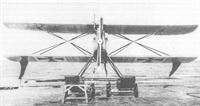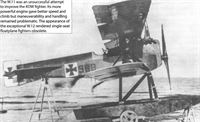
Описание
Страна: Германия
Год: 1916
Варианты
- Hansa-Brandenburg - D.I/KD - 1916 - Германия
- Hansa-Brandenburg - KDD - 1916 - Германия
- Hansa-Brandenburg - KDW - 1916 - Германия
- Hansa-Brandenburg - W.11 - 1916 - Германия
- Hansa-Brandenburg - C.II / K - 1917 - Германия
- Hansa-Brandenburg - W.25 - 1917 - Германия
- Phonix - C.I - 1917 - Австро-Венгрия
- Phonix - D.I/D.II/D.III - 1917 - Австро-Венгрия
- Phonix - D.IV / 20.24 / 20.25 - 1918 - Австро-Венгрия
- В.Обухович, А.Никифоров Самолеты Первой Мировой войны
- O.Thetford, P.Gray German Aircraft of the First World War (Putnam)
- W.Green, G.Swanborough The Complete Book of Fighters
- J.Herris German Seaplane Fighters of WWI (A Centennial Perspective on Great War Airplanes 2)
- C.Owers Hansa-Brandenburg Aircraft of WWI Vol.2: Biplane Seaplanes (A Centennial Perspective on Great War Airplanes 18)
- M.Dusing German Aviation Industry in WWI. Volume 1 (A Centennial Perspective on Great War Airplanes 84)
-
C.Owers - Hansa-Brandenburg Aircraft of WWI. Volume 2 - Biplane Seaplanes /Centennial Perspective/ (18)
Brandenburg W.11 Marine Number 989 was based at Seeflugstation Flandern 1 at Zeebrugge
-
J.Herris - Development of German Warplanes in WWI /Centennial Perspective/ (1)
The W.11 was an enlarged, more powerful KDW powered by a 200 hp Benz Bz.IV. It was somewhat faster, but inherited the KDW's stability and handling problems and only three were built. At least two were assigned to naval air stations on the Flanders coast.
-
C.Owers - Hansa-Brandenburg Aircraft of WWI. Volume 2 - Biplane Seaplanes /Centennial Perspective/ (18)
The W.11 was a slightly enlarged, more powerful version of the KDW fighter retaining the "star strutter" bracing of its predecessor and looks virtually identical; the Marine Number is the fool-proof way to tell the difference.
-
J.Herris - German Seaplane Fighters of WWI /Centennial Perspective/ (2)
W11 Marine Number unknown; this type was a slightly enlarged KDW with two machine guns and the more powerful 200 hp Benz Bz.IV engine. Only three aircraft, marine numbers 988-990, were built in late 1916 due to the marginal improvement over the KDW. Of the three aircraft built, at least two, Marine Numbers 988 and 989, were assigned to Flandern 1 at Zeebrugge.
-
Jane's All The World Aircraft 1919 /Jane's/
An Ago (???) Seaplane of 1918 type
-
C.Owers - Hansa-Brandenburg Aircraft of WWI. Volume 2 - Biplane Seaplanes /Centennial Perspective/ (18)
If not for the Marine Number 988 the W.11 can be mistaken for a KDW fighter retaining the "star strutter" bracing of its predecessor.
The W11 derivative of the KDW was tested in 1917, but only prototypes were completed. -
C.Owers - Hansa-Brandenburg Aircraft of WWI. Volume 2 - Biplane Seaplanes /Centennial Perspective/ (18)
The W.11 was an unsuccessful attempt to improve the KDW fighter. Its more powerful engine gave better speed and climb but maneuverability and handling remained problematic. The appearance of the exceptional W.12 rendered single-seat floatplane fighters obsolete.
-
C.Owers - Hansa-Brandenburg Aircraft of WWI. Volume 2 - Biplane Seaplanes /Centennial Perspective/ (18)
Rear quarter view of W.11; from this vantage point it still looks like a KDW.
-
C.Owers - Hansa-Brandenburg Aircraft of WWI. Volume 2 - Biplane Seaplanes /Centennial Perspective/ (18)
Brandenburg W.11 SVK Drawing
-
C.Owers - Hansa-Brandenburg Aircraft of WWI. Volume 2 - Biplane Seaplanes /Centennial Perspective/ (18)
Brandenburg W.11 Factory Drawing
В.Обухович, А.Никифоров Самолеты Первой Мировой войны
На основе KD был разработан поплавковый одноместный разведчик-истребитель KDW. В серии строился увеличенный вариант под индексами W11 (с двигателем Bz.IV) и W25 (с Bz.III).
Описание:











